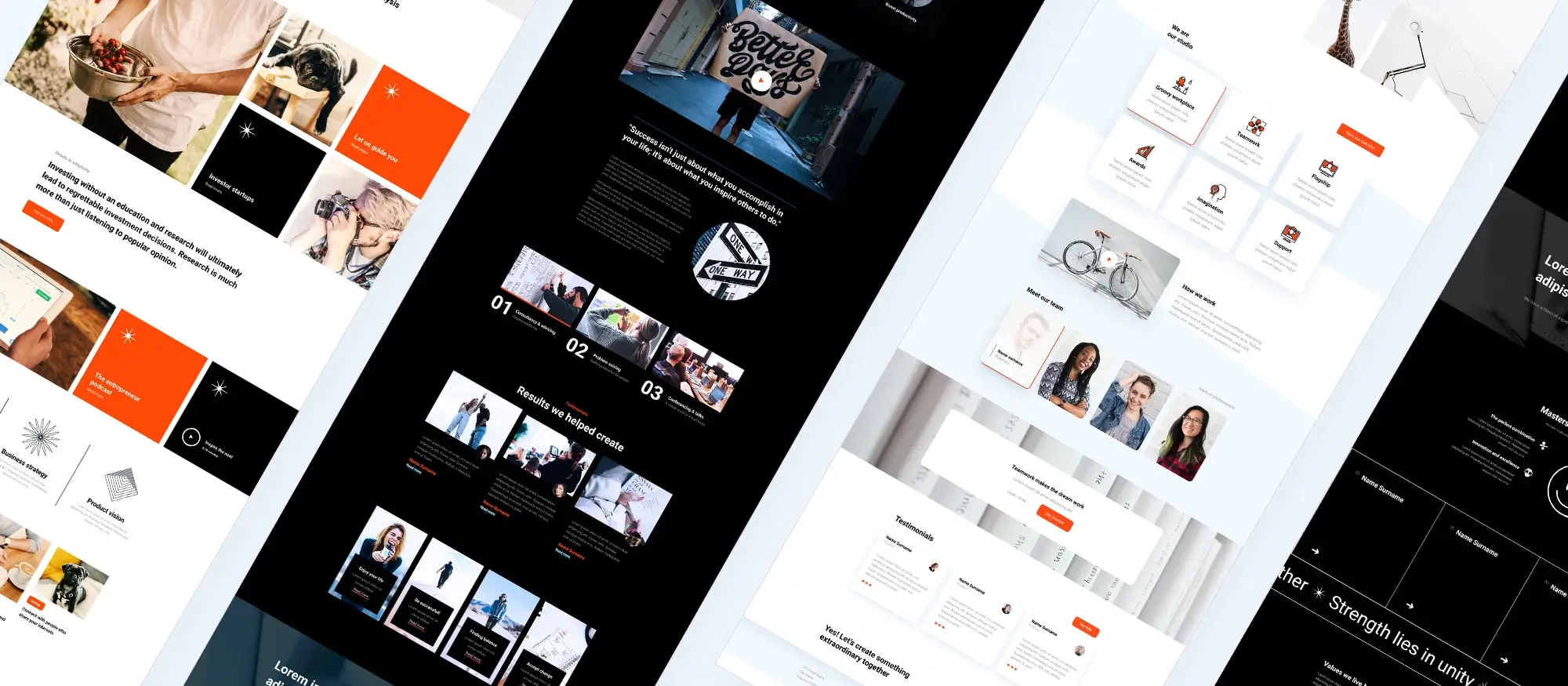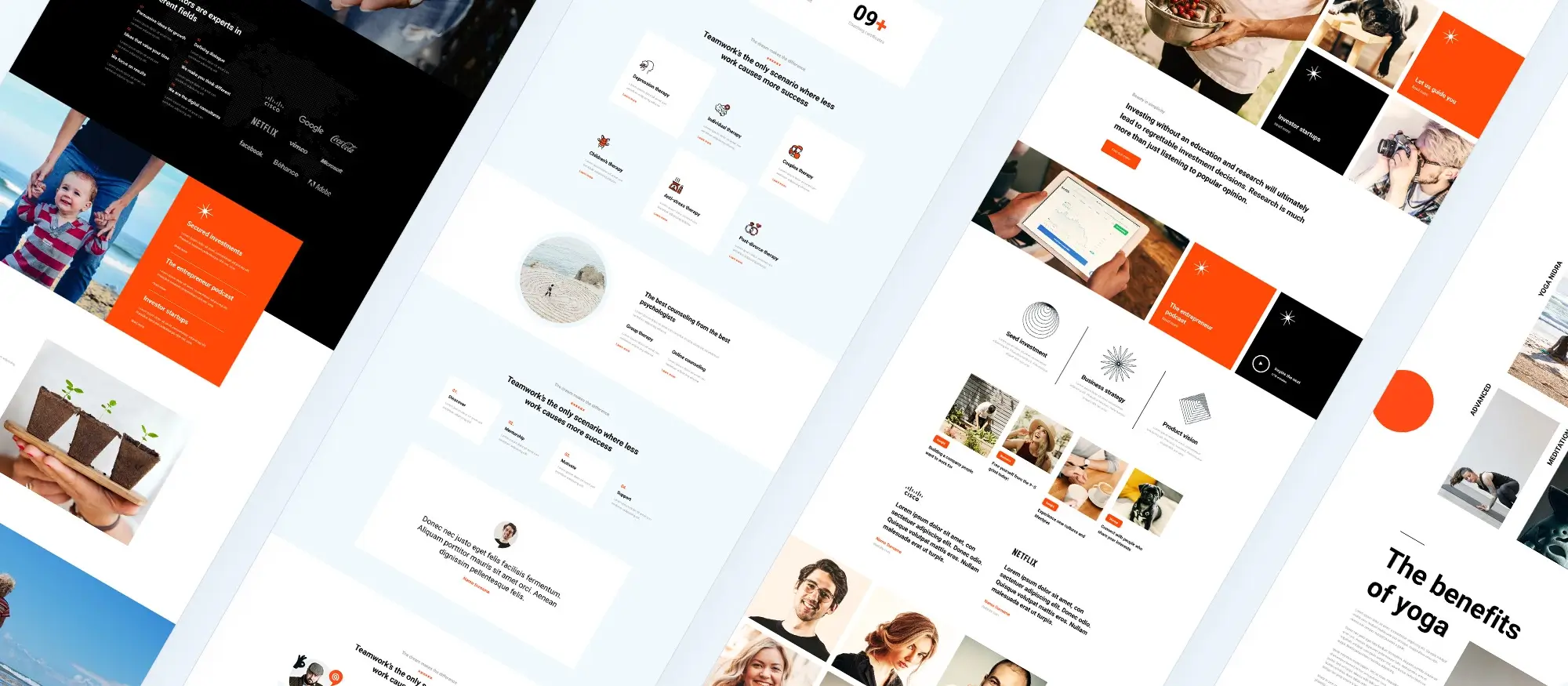Case studies: Successful WordPress website designs and what we can learn from them
Try MaxiBlocks for free with 500+ library assets including basic templates. No account required. Free WordPress page builder, theme and updates included.

Updated 15th May 2025
Understanding website case studies and WordPress success stories
Studying well-executed website designs offers a wealth of insight for designers, developers and business owners. By exploring detailed case studies, you can learn from real-world examples, understand the reasoning behind design decisions, and apply practical takeaways to improve your own projects.
What is a case study in WordPress?
A WordPress case study examines the design, development and performance of a particular website built on the WordPress platform. It typically involves analysing how the site was planned, which features were implemented, and how well the site meets its goals. These case studies often highlight specific challenges and the strategies used to overcome them, offering valuable guidance for those creating similar websites.
For example, a case study might focus on a business site that increased conversions through improved navigation or a blog that grew its audience by refining its content structure and layout. These insights are especially helpful when you want to make evidence-based decisions in your own design work.
What is a case study in a website context?
In broader terms, a website case study is a detailed account of how a website was created and how it performs. It typically includes planning stages, design approaches, development solutions, and user experience outcomes. Whether built on WordPress or another platform, the goal is to understand what contributed to the site’s success.
A good case study doesn’t just showcase visuals it explains why certain choices were made and how they impacted user engagement, performance or conversions. This level of analysis makes case studies useful for identifying patterns and best practices across different industries and use cases.
What are WordPress websites best for?
WordPress is one of the most versatile website platforms available, which is why it powers such a large portion of the web. It’s particularly well-suited for blogs, business websites, e-commerce shops, news platforms, portfolios and membership-based services.
Its flexibility comes from a combination of customisable themes and a wide range of plugins, making it easy to tailor a site’s functionality without starting from scratch. Whether you need a simple site or a robust online platform, WordPress can adapt to your needs making it a top choice for case studies focused on real-world web design success.

Showcasing and learning from WordPress case studies
Case studies are a powerful way to build trust, demonstrate expertise, and share the thinking behind your design process. Whether you’re presenting your own work or learning from others, knowing how to organise and display case studies can add real value to your website and your development practice.
How to display case studies on a website
If you’ve worked on projects that demonstrate strong results or creative problem-solving, a dedicated case study section can be a compelling addition to your site. This could take the form of a standalone page, a portfolio section, or a series of blog-style entries that break down your process.
Each case study should clearly present the project’s background, the challenges faced, the solutions implemented, and the results achieved. Use visual elements such as screenshots, mockups, or even short videos to support your story and bring your process to life. Well-structured layouts, headings, and calls to action can make these pages easier to read and more engaging.
If you’re using WordPress, there are tools and plugins available such as case study templates or custom post types that make it easier to organise and manage these entries consistently across your site.
Free case studies: successful WordPress website designs and what we can learn
Analysing free case studies from successful WordPress websites can provide practical inspiration for your own projects. These examples offer a detailed look at how different sites have been structured, styled and optimised to meet specific goals.
From creative agencies to online stores, these case studies highlight the importance of good design, clear user journeys, fast performance, and purposeful content. You can learn from how others have approached common challenges such as increasing engagement, improving conversions or streamlining site navigation and adapt those lessons to suit your own website goals.
By regularly reviewing high-quality case studies, you’ll stay informed about design trends, best practices and user-focused thinking all of which can strengthen your own work.
Subscribe to our newsletter
Tools, examples and formats for WordPress website case studies
Presenting your design work clearly and professionally can help you build credibility and attract more clients or collaborators. Whether you’re using plugins, drawing inspiration from well-executed sites, or preparing downloadable resources, there are many ways to make the most of your case studies.
WordPress case study plugins for your website
To showcase your case studies within WordPress, you can use dedicated plugins designed to present your work in a structured and visually appealing way. Tools such as WP Case Study or WP Portfolio allow you to display projects using customisable layouts and interactive elements.
These plugins often integrate easily with your existing theme and make it simple to organise case studies by category, client, or project type. Features like built-in filtering, lightbox image displays, and responsive design support help you create a polished and professional-looking portfolio.
Website case study examples
Looking at live examples of well-designed websites can offer insights into layout, content structure and user engagement.
TechCrunch is a strong example of a clean, content-heavy website that remains highly usable. The design is minimalist, with clearly defined sections and effective use of whitespace and typography to enhance readability.
BBC America uses multimedia elements, including video and interactive features, in a seamless way. The design balances visual engagement with accessibility, offering a smooth experience even with large amounts of content.
The Walt Disney Company presents a cohesive, branded experience across its entire site. High-quality visuals, consistent design patterns, and intuitive navigation contribute to a polished and immersive experience for users.
These examples show how thoughtful design and strategic content structure can create strong, memorable websites that align with brand goals and audience expectations.
Creating a website design case study PDF
Packaging your case studies as PDFs is a great way to make them portable and easy to share. A well-crafted PDF case study typically includes an overview of the project, objectives, challenges, solutions and outcomes. Supporting visuals such as wireframes, mockups or screenshots help illustrate your process and results.
PDFs are particularly useful for client presentations, downloadable resources, or portfolio submissions where internet access may be limited. They also allow you to include longer-form content and design details in a controlled, print-ready format.

More website design case study examples
Studying websites from a variety of industries and audiences helps uncover practical lessons about layout, accessibility, content presentation and overall user experience. These examples show how thoughtful design choices support the goals of each organisation while delivering a high-quality experience for users.
The New Yorker
The New Yorker’s website is a strong example of how simplicity and typography can work together to enhance content. The design makes excellent use of white space, allowing text and images to breathe while maintaining a strong visual hierarchy.
Headlines are bold and elegant, while body text is carefully styled for readability across devices. The layout supports a high volume of articles without feeling cluttered, guiding readers naturally from one section to the next. This design places the focus firmly on content, encouraging longer engagement and return visits.
The Obama Foundation
The Obama Foundation’s website is designed with accessibility and inclusion at its core. From the outset, the layout is clean and straightforward, with clear navigation and minimal distractions.
Key accessibility features include scalable text sizes, high-contrast colour choices and full keyboard navigation support. These considerations ensure the site is usable by people with varying abilities and assistive technologies. It reflects a commitment to universal access, showing that good design is about more than aesthetics it’s also about equity and usability.
Build like a pro
Exploring free case studies and interactive design inspiration
Looking at how other professionals present their work can help you refine your own process. Free and interactive case studies provide not just creative inspiration, but also practical insights into how successful websites are built, structured and improved over time.
Free case study websites
There are several platforms where designers and developers share detailed case studies of their work, often for free. On sites like Behance and Dribbble, you’ll find projects that include breakdowns of design decisions, goals, and results across various industries. These platforms not only showcase visual styles but also reveal the thinking and strategy behind the final designs.
Meanwhile, galleries such as Awwwards feature award-winning sites with commentary on structure, usability, and innovation. Exploring these examples regularly can help you stay current with trends, techniques and evolving user expectations.
Case study page examples
A strong case study page should guide the reader through the full story of a project starting with the challenge, followed by the design approach, and ending with measurable results. Good examples of this format can be found on content-driven sites like HubSpot, where each case study is well-structured, visually clear and easy to navigate.
The most effective pages combine strong copywriting with visuals like wireframes, screenshots or videos, giving users a complete view of the design and development journey.
Interactive case study examples
Interactive case studies take the learning experience further by engaging users with animations, clickable elements or embedded video walkthroughs. This approach is particularly useful when the case study involves complex data, layered designs or dynamic functionality.
Websites like Adobe and IBM present interactive case studies that not only showcase their products or projects but also demonstrate their capabilities in delivering immersive, user-centred design. These examples show how multimedia can be used not just for style, but to communicate process and value more clearly.

Final thoughts and key takeaways
Exploring website case studies is one of the most practical ways to learn what works in real-world design. From how a layout improves user flow, to how accessibility features increase engagement, case studies provide the kind of insight that goes beyond theory. They reveal the thought processes behind successful sites and offer strategies that can be adapted to your own projects.
Key takeaways include the importance of storytelling in presenting your work, the value of combining visual elements with measurable outcomes, and the benefit of studying case studies from a range of industries and styles. Whether you’re showcasing your own work or learning from others, a well-structured case study can demonstrate not just what was built but why it mattered.
If you’re looking to bring these lessons into your own website design process, MaxiBlocks is a powerful tool that can help you translate strategy into execution. Its visual builder works seamlessly with the MaxiBlocks Go theme, giving you the flexibility to design custom layouts, create interactive case studies, and present your work with clarity and style.
Whether you’re building from scratch or upgrading your portfolio, MaxiBlocks gives you the design freedom and structure needed to create a polished, professional site that reflects the quality of your work.
Beautiful WordPress web designs to kickstart your site
Find responsive and accessible WordPress web designs to match your brand and goals.
FAQs about successful WordPress website designs
What makes a WordPress website design successful?
A successful WordPress website design strikes a balance between aesthetics, usability and performance. It should look professional, be easy to navigate, load quickly, and offer a seamless experience across all devices. Just as importantly, the content should be purposeful and aligned with the needs of the target audience.
Why is it important to study successful WordPress website designs?
Studying successful designs helps you understand what works in practice. It can highlight best practices, spark creative ideas, and reveal solutions to common challenges. By learning from others, you reduce the chances of making avoidable mistakes and increase the effectiveness of your own website.
What are some common features of successful WordPress website designs?
Most successful WordPress sites share a few key features. These include responsive layouts, fast loading times, strong visual hierarchy, high-quality images, clear typography and compelling calls to action. Together, these elements contribute to a user-friendly experience that keeps visitors engaged.
How can I create a successful WordPress website design?
Start by choosing a reliable theme that suits your brand and your audience’s expectations. Use a page builder to customise layouts, ensure your site is mobile-responsive and optimise for speed. Focus on providing valuable, well-structured content, and test your design regularly to keep it performing well.
What role does user experience (UX) play in successful WordPress website designs?
UX plays a central role in how visitors interact with your site. A good user experience ensures users can find what they need quickly, understand your messaging clearly, and enjoy a smooth journey through the site. This leads to better engagement, increased conversions and a more positive brand impression.
How can I ensure my WordPress site is mobile-friendly?
Use a responsive theme that adapts to different screen sizes and devices automatically. Test your site on mobile phones and tablets to make sure content is readable and interactive elements work properly. Also, optimise images and reduce unnecessary scripts to speed up loading times on mobile.
How important is website speed in successful WordPress website designs?
Speed is essential. A slow website can drive users away before they’ve even seen your content. Fast-loading pages create a better user experience, support SEO, and improve conversion rates. Compress images, limit unnecessary plugins, and use caching to keep your site running efficiently.
Can case studies of successful WordPress websites provide valuable insights?
Yes, case studies offer detailed, real-world examples of what works. They often cover the design process, content strategy and technical decisions that led to a site’s success. Studying these examples can help you identify techniques and approaches worth applying to your own site.
What are some examples of successful WordPress website designs?
Examples span a wide range of industries. From media outlets and tech companies to e-commerce brands and personal portfolios, WordPress is used to power many high-performing websites. Look for examples in agency portfolios, theme showcases and award directories for inspiration.
How can I continuously improve my WordPress website design?
Improvement is ongoing. Regularly review analytics to understand user behaviour, seek feedback from real users, and stay current with design trends and best practices. Updating content, refining layouts and testing new features will help your site evolve with your audience’s needs.
What makes a hero section such a crucial part of web design?
The hero section is the first visual element users engage with, often used to introduce your brand message or key offering. For examples that show how to create a strong visual impact, this hero banner gallery showcases a range of effective designs.
Can I build a hero section in WordPress without technical skills?
Yes, absolutely. The Maxiblocks hero section builder for WordPress lets you design beautiful, responsive hero areas using simple drag-and-drop tools, making it ideal for beginners and professionals alike.
Is there a Maxiblocks tool specifically designed for hero sections?
The Maxiblocks website hero section builder is built to help you create engaging hero layouts with minimal effort. It includes customisable templates and responsive design features that work seamlessly with WordPress.
What tools can I use to design a full website more efficiently?
Whether you’re just getting started or looking to streamline your workflow, this guide to website design software covers reliable tools that support creativity, performance and ease of use.
How do I make my website responsive across all devices?
Responsive web design ensures your site looks great on any screen size, from smartphones to desktops. To learn how to structure your layout and optimise for performance, this complete responsive design guide walks you through the best practices step by step.
WordPress itself
Official Website
wordpress.org – This is the official website for WordPress, where you can download the software, find documentation, and learn more about using it.
WordPress Codex
codex.wordpress.org/Main_Page – This is a comprehensive documentation resource for WordPress, covering everything from installation and configuration to specific functionality and troubleshooting.
WordPress Theme Directory
wordpress.org/themes – The official WordPress theme directory is a great place to find free and premium WordPress themes. You can browse themes by category, feature, and popularity.
maxiblocks.com/go/help-desk
maxiblocks.com/pro-library
www.youtube.com/@maxiblocks
twitter.com/maxiblocks
linkedin.com/company/maxi-blocks
github.com/orgs/maxi-blocks
wordpress.org/plugins/maxi-blocks

Kyra Pieterse
Author
Kyra is the co-founder and creative lead of MaxiBlocks, an open-source page builder for WordPress Gutenberg.
You may also like

